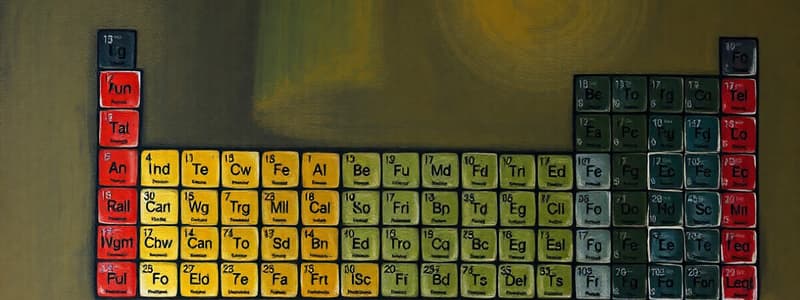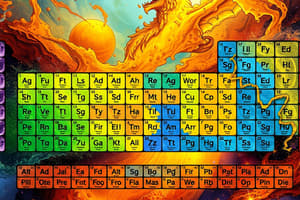Podcast
Questions and Answers
What aspect of the elements is primarily categorized in the periodic table?
What aspect of the elements is primarily categorized in the periodic table?
- Chemical properties (correct)
- Physical form
- Weight distribution
- Color variations
Which of the following best describes the role of defects in the context of the periodic table?
Which of the following best describes the role of defects in the context of the periodic table?
- They are irrelevant to the grouping of elements.
- They can affect the reproducibility of element properties. (correct)
- They enhance the properties of elements.
- They represent new elements discovered in the periodic table.
Cements as discussed in the context of the periodic table are primarily classified under which category?
Cements as discussed in the context of the periodic table are primarily classified under which category?
- Inorganic solutions
- Typical elements (correct)
- Organic compounds
- Composite materials
How are elements positioned in the periodic table?
How are elements positioned in the periodic table?
What might the third period in the periodic table represent?
What might the third period in the periodic table represent?
Which of the following is NOT a property typically associated with elements in the periodic table?
Which of the following is NOT a property typically associated with elements in the periodic table?
What is a characteristic feature of elements in the same group of the periodic table?
What is a characteristic feature of elements in the same group of the periodic table?
Which of the following statements about the elements and their properties is accurate?
Which of the following statements about the elements and their properties is accurate?
What do we call the collective characteristics of electrons in the periodic table?
What do we call the collective characteristics of electrons in the periodic table?
Which group of elements is typically known for their variable valences?
Which group of elements is typically known for their variable valences?
What characteristic is most commonly associated with transition metals?
What characteristic is most commonly associated with transition metals?
Which group of elements generally has colored compounds?
Which group of elements generally has colored compounds?
Which property mainly distinguishes alkali metals from other groups in the periodic table?
Which property mainly distinguishes alkali metals from other groups in the periodic table?
What can be said about the boiling points of alkali metals compared to transition metals?
What can be said about the boiling points of alkali metals compared to transition metals?
Which of the following statements about lanthanides is true?
Which of the following statements about lanthanides is true?
What is the primary characteristic of the group mentioned in the content?
What is the primary characteristic of the group mentioned in the content?
Which element is mentioned as part of the group that increases in size successively?
Which element is mentioned as part of the group that increases in size successively?
Which group does not typically form compounds with variable oxidation states?
Which group does not typically form compounds with variable oxidation states?
What trend is associated with the elements in this group?
What trend is associated with the elements in this group?
What type of compounds do these elements typically form?
What type of compounds do these elements typically form?
What is the significance of the 'oxide group' in relation to these elements?
What is the significance of the 'oxide group' in relation to these elements?
What does Mendeleev's Periodic Law state about the relationship between properties of elements and their atomic masses?
What does Mendeleev's Periodic Law state about the relationship between properties of elements and their atomic masses?
Why did Mendeleev leave gaps in his periodic table?
Why did Mendeleev leave gaps in his periodic table?
How did Mendeleev categorize the elements in his periodic table?
How did Mendeleev categorize the elements in his periodic table?
What is indicated by the term 'group number' in Mendeleev's Periodic Table?
What is indicated by the term 'group number' in Mendeleev's Periodic Table?
What was the main progression of elements as stated by Mendeleev in a period?
What was the main progression of elements as stated by Mendeleev in a period?
What was Mendeleev's notation for representing elements of a particular group?
What was Mendeleev's notation for representing elements of a particular group?
What special consideration did Mendeleev make for isotopes in his periodic table?
What special consideration did Mendeleev make for isotopes in his periodic table?
Which two elements did Mendeleev point out as examples that bear no chemical similarities?
Which two elements did Mendeleev point out as examples that bear no chemical similarities?
What is the term used for the measure of an element's ability to bond with other elements?
What is the term used for the measure of an element's ability to bond with other elements?
Which group typically contains elements with the highest valency?
Which group typically contains elements with the highest valency?
Which of the following elements is likely to have a valency of +1?
Which of the following elements is likely to have a valency of +1?
What does group valency refer to in the context of elements?
What does group valency refer to in the context of elements?
Elements with a valency of 0 are primarily found in which group?
Elements with a valency of 0 are primarily found in which group?
What is the relationship between valency and the number of outer electrons in an element?
What is the relationship between valency and the number of outer electrons in an element?
Which of the following elements generally has a valency of +2?
Which of the following elements generally has a valency of +2?
How does valency generally affect the stability of an atom during a chemical reaction?
How does valency generally affect the stability of an atom during a chemical reaction?
Flashcards are hidden until you start studying
Study Notes
Mendeleev’s Periodic Law
- In a period, elements gradually change from metallic to non-metallic character as you move down the periodic table
- Physical and chemical properties are a periodic function of their atomic masses
- The same element always has the same chemical properties
Mendeleev’s Periodic Table
- Mendeleev's Periodic Table was published in 1872
- He left gaps where he thought undiscovered elements would eventually be found
- Mendeleev correctly thought that there should be a separate place in the periodic table for isotopes of elements, since isotopes share chemical properties but have different atomic masses
- Mendeleev used the letter “R” to represent the element of a particular group
- Hydrides of any element of group IV are written as RH4, for example, CH4
- Oxides of any element of the same group are written as RO, for example, CO
Grouping of Elements
- Elements in the same group (vertical column) have similar properties
- Elements in the same period (horizontal row) have properties that change gradually
The Main Groups (1-18)
- Have similar properties
- Mostly metallic (e.g., lithium, sodium, potassium), some are semi-metals (e.g., arsenic)
- The character of elements becomes more acidic as you move down a group
- For example, lithium is a metal; it has the strongest metallic character in the group and is extremely reactive
- For example, caesium is a metal; it is a weak metal with less reactivity than lithium
- Elements become larger as you move down a group; size increases
- Elements become less reactive as you move down a group
The Transitional Metals
- Have similar properties
- Mostly metals (e.g., Copper, Silver, Gold)
- Have variable valency, which is the ability to form different ions
- Elements in the same group (vertical column) have similar properties
Defects in Mendeleev’s Periodic Law
- Mendeleev's law states that elements gradually change from metallic to a non-metallic character as you move across the period, but there are exceptions
- Mendeleev's law doesn't clarify why properties repeat periodically
- It doesn't account for position of isotopes, for example, isotopes of an element must be given separate places in the periodic table since they have different atomic masses, but Mendeleev's table doesn’t assign separate places to isotopes
- It groups chemically dissimilar elements in the same group, for example, copper and silver bear no relation to each other
- Atomic masses are not always consistent
- Mendeleev’s law fails to explain the periodicity of chemical properties
Studying That Suits You
Use AI to generate personalized quizzes and flashcards to suit your learning preferences.




